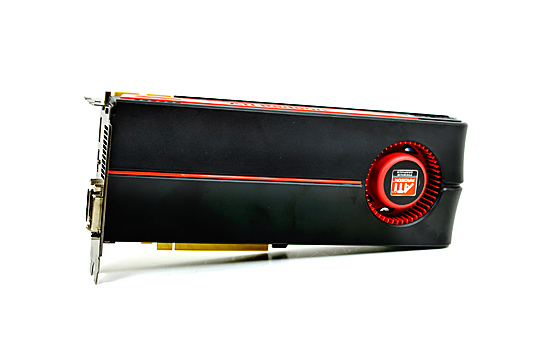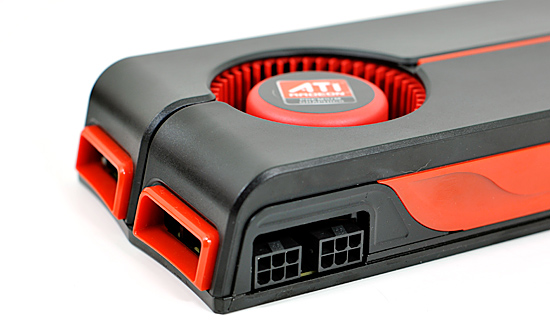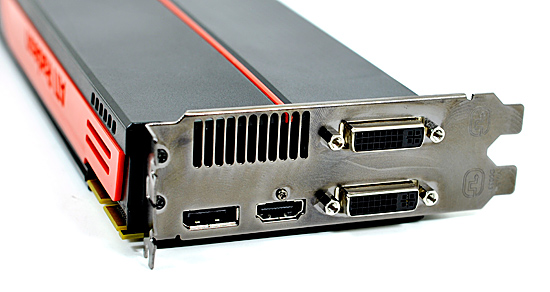AMD's Radeon HD 5870: Bringing About the Next Generation Of GPUs
by Ryan Smith on September 23, 2009 9:00 AM EST- Posted in
- GPUs
Meet the 5870
The card we’re looking at today is the Radeon HD 5870, based on the Cypress core.

Compared to the Radeon HD 4870, the 5870 has seen some changes to the board design. AMD has now moved to using a full sheath on their cards (including a backplate), very much like the ones that NVIDIA has been using since the 9800GTX. The card measures 10.5” long, an inch longer than the 4890 or the same as the 4870x2 and the NVIDIA GTX lineup.
The change in length means that AMD has moved the PCIe power connectors to the top of the card facing upwards, as there’s no longer enough room in the rear. Facing upwards is also a change from the 4870x2, which had them facing the front of the card. This, in our opinion, makes it easier to plug and unplug the PCIe power connectors, since it’s now possible to see what you’re doing.
Since the card has a TDP of 188W, AMD can still get away with using two 6-pin connectors. This is going to be good news for those of you with older power supplies that don’t feature 8-pin connectors, as previously the fastest cards without 8-pin connectors were the 4890 and GTX 285.

Briefly, the 5850 that we are not testing today will be slightly smaller than the 5870, coming in at 9.5”. It keeps the same cooler design, however the PCIe power connectors are back on the rear of the card.
With the 5800 series, DisplayPort is getting a much-needed kick in the pants. DisplayPort (full size) is standard on all 5800 series cards – prior to this it has been rather absent on reference cards. Along with a DisplayPort, the 5870 reference card contains a dedicated HDMI port, and a pair of DVI ports.
Making 4 ports fit on a card isn’t a trivial task, and AMD has taken an interesting direction in making it happen. Rather than putting every port on the same slot of the bracket as the card itself, one of the DVI ports is raised on to the other bracket. ATI could have just as easily only equipped these cards with 1 DVI port, and used an HDMI-to-DVI adapter for the second port. The advantage of going this direction is that the 5800 series can still drive two VGA monitors when using DVI-to-VGA adapters, and at the same time having an HDMI port built in means that no special adapters are necessary to get an HDMI port with audio capabilities. The only catch to this specific port layout is that the card still only has enough TMDS transmitters for two ports. So you can use 2x DVI or 1x DVI + HDMI, but not 2x DVI + HDMI. For 3 DVI-derived ports, you will need an active DisplayPort-to-DVI adapter.
With the configuration AMD is using, fitting that second DVI port also means that the exhaust vent of the 5800 series cards is not the full length of the card as is usually common, rather it’s a hair over half the length. The smaller size had us concerned about the 5870’s cooling capabilities, but as you’ll see with our temperature data, even with the smaller exhaust vent the load temperatures are no different than the 4870 or 4850, at 89C. And this is in spite of the fact that the 5870 is rated 28W more than the 4870.

With all of these changes also comes some changes to the loudness of the 5870 as compared to the 4870. The 27W idle power load means that AMD can reduce the speed of the fan some, and they say that the fan they’re using now is less noticeable (but not necessarily quieter) than what was on the 4870. In our objective testing the 5870 was no quieter than any of the 4800 series cards when it comes to idling at 46.6dB, and indeed it’s louder than any of those cards at 64dB at load. But in our subjective testing it has less of a whine. If you go by the objective data, this is a push at idle and louder at load.
Speaking of whining, we’re glad to report that the samples we received do not have the characteristic VRM whine/singing that has plagued many last-generation video cards. Most of our GTX cards and roughly half of our 4800 series cards generated this noise under certain circumstances, but the 5870 does not.
Finally, let’s talk about memory. Despite of doubling just about everything compared to RV770, Cypress and the 5800 series cards did not double their memory bandwidth. Moving from the 4870 and it’s 900MHz base memory clock, the 5870 only jumps up by 33% to 1.2Ghz, in effect increasing the ratio of GPU compute elements to memory bandwidth.
When looking back at the RV770, AMD believes that they were not bandwidth starved on the cards that used GDDR5. And since they had more bandwidth than they needed, it was not necessary to go for significantly more bandwidth for Cypress. This isn’t something we can easily test, but in our benchmarks the 5870 never doubles the performance of the 4870, in spite of being nearly twice the card. Graphics processing is embarrassingly parallel, but that doesn’t mean it perfectly scales. The different may be a product of that or a product of the lack of scaling in memory bandwidth, we can’t tell. What’s for certain however is that we don’t have any hard-capped memory bandwidth limited situations, the 5870 always outscores the 4870 by a great deal more than 33%.










327 Comments
View All Comments
SiliconDoc - Sunday, September 27, 2009 - link
I'll be watching you for the very same conclusion when NVidia launches soft and paper.I'll bet ten thousand bucks you don't say it.
I'll bet a duplicate amount you're a red rager fan, otherwise YOU'D BE HONEST, NOT HOSTILE !
rennya - Thursday, September 24, 2009 - link
It may be paper-launch in the US, but here somewhere in South East Asia I can already grab a Powercolor 5870 1GB if I so desire. Powercolor is quite aggresive here promoting their ATI 5xxx wares just like Sapphire does when the 4xxx series comes out.SiliconDoc - Thursday, September 24, 2009 - link
I believe you. I've also seen various flavors of cards not available here in the USA, banned by the import export deals and global market and manufacturer and vendor controls and the powers that be, and it doesn't surprise me when it goes the other way.Congratulations on actually having a non fake launch.
Spoelie - Wednesday, September 23, 2009 - link
"The engine allows for complete hardware offload of all H.264, MPEG-2 and VC1 decoding".This has afaik never been true for any previous card of ATi, and I doubt it has been tested to be true this time as well.
I have detailed this problem several times before in the comment section and never got a reply, so I'll summarize: ATi's UVD only decodes level 4 AVC (i.e. bluray) streams, if you have a stream with >4 reference frames, you're out of luck. NVIDIA does not have this limitation.
lopri - Wednesday, September 23, 2009 - link
Yeah and my GTX 280 has to run full throttle (3D frequency) just to play a 720p content and temp climbs the same as if it were a 3D game. Yeah it can decode some *underground* clips from Japan, big deal. Oh and it does that for only H.264. No VC-1 love there. I am sure you'd think that is not a big deal, but the same applies to those funky clips with 13+ reference frames. Not a big deal. Especially when AMD can decode all 3 major codecs effortlessly (performance 2D frequency instead of 3D frequency)rennya - Thursday, September 24, 2009 - link
G98 GPUs (like 8400GS discrete or 9400 chipset) or GT220/G210 can also do MPEG2/VC-1/AVC video decoding.The GPU doesn't have to run full throttle either, as long as you stick to the 18x.xx drivers.
SJD - Wednesday, September 23, 2009 - link
Ryan,Great article, but there is an inconsistancy. You say that thanks to there only being 2 TDMS controllers, you can't use both DVI connectors at the same time as the HDMI output for three displays, but then go onto say later that you can use the DVI(x2), DP and HDMI in any combination to drive 3 displays. Which is correct?
Also, can you play HDCP protected content (a Blu-Ray disc for example) over a panel connected to a Display Port connector?
Otherwise, thanks for the review!
Ryan Smith - Wednesday, September 23, 2009 - link
It's the former that is correct: you can only drive two TDMS devices. The article has been corrected.And DP supports HDCP, so yes, protected content will play over DP.
SJD - Friday, September 25, 2009 - link
Thanks for clarifying that Ryan - It confirms what I thought.. :-)chowmanga - Wednesday, September 23, 2009 - link
I'd like to see a benchmark using an amd cpu. I think it was the Athlon II 620 article that pointed out how Nvidia hardware ran better on AMD cpus and AMD/ATI cards ran better on Intel cpus. It would be interesting to see if the 5870 stacks up against Nv's current gen with other setups.